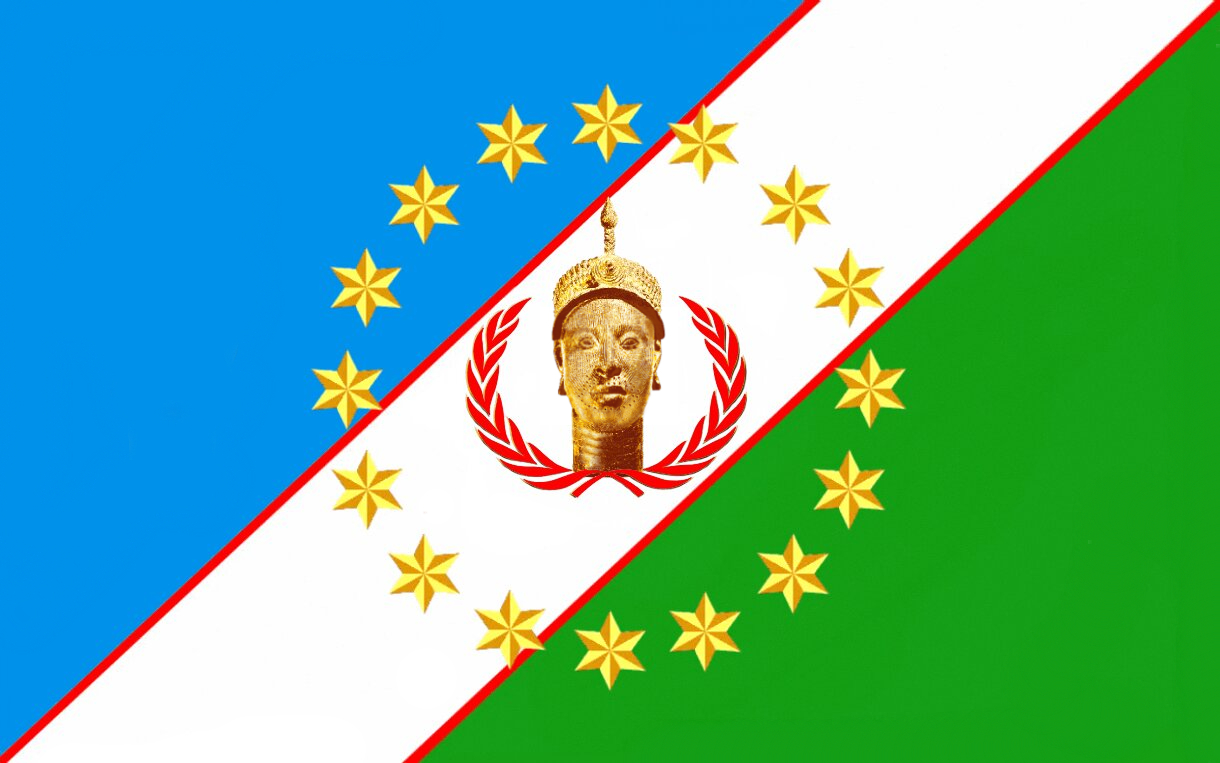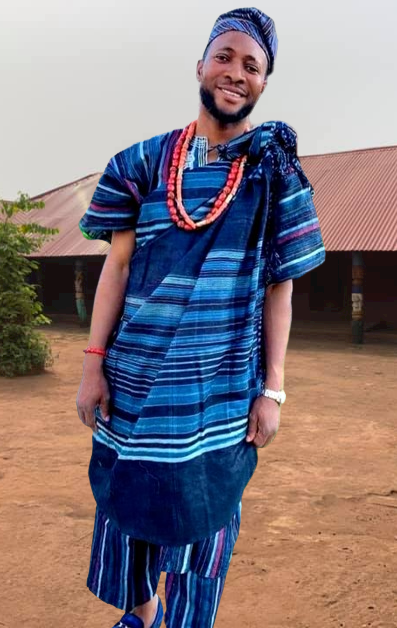|
Aso Olona
Aso Olona is a traditional Yoruba textile known for its intricate geometric patterns and cultural significance, particularly among the Ijebu subgroup. The term "Aso Olona" translates to "cloth with patterns" in the Yoruba language. Aso Olona is an handwoven fabrics that can come with motifs like the chameleon. The Aso Olona is often woven with symbols that carry meanings. It is used in various traditional Yoruba attires, including the Kaja or Pakaja, a Yoruba draped outfit. Also, Aso Olona is used for Iro ati Buba, a combination of a loose-fitting blouse and a large wrapper. It's also paired with accessories like Gele (head-tie), Ipele (shawl), and adorned with beads and jewelry that hold cultural significance. Aso Olona Ipeles called Itagbe were especially common for Ogboni events.The cloth is used as a title cloth for the Ogboni/Oshugbo society, which is a powerful and secretive association of elders and leaders in Yoruba society. The cloth is also worn by chiefs, prie ... [...More Info...] [...Related Items...] OR: [Wikipedia] [Google] [Baidu] |
Ijebu Woman In Aso Olona , a local government area in Ogun State, Nigeria
{{disambiguation, geo ...
Ijebu may also refer to: People * Ijebu Kingdom, Yoruba kingdom in pre-colonial Nigeria *Ijebu people, an ethnic subtribal group from Nigeria Places *Ijebu, Owo, a local government area of Ondo State, south-western Nigeria * Ijebu Diocese of the Church of Nigeria * Ijebu-Ode Diocese of the Catholic Church *Ijebu East, a local government area in Ogun State, Nigeria *Ijebu Igbo, a town in Ogun State, Nigeria *Ijebu Ode, a town in Ogun State, Nigeria *Ijebu North, a local government area in Ogun State, Nigeria *Ijebu North East Ijebu North East is a Local Government Areas of Nigeria, Local Government Area in Ogun State, Nigeria. Its headquarters are in the town of Atan at . The postal code of the area is 120. References {{Authority control Local Government Area ... [...More Info...] [...Related Items...] OR: [Wikipedia] [Google] [Baidu] |
Yoruba People
The Yoruba people (, , ) are a West African ethnic group that mainly inhabit parts of Nigeria, Benin, and Togo. The areas of these countries primarily inhabited by Yoruba are often collectively referred to as Yorubaland. The Yoruba constitute more than 42 million people in Africa, are a few hundred thousand outside the continent, and bear further representation among members of the African diaspora. The vast majority of the Yoruba population is today within the country of Nigeria, where they make up 21% of the country's population according to CIA estimations, making them one of the largest ethnic groups in Africa. Most Yoruba people speak the Yoruba language, which is the Niger-Congo language with the largest number of native or L1 speakers. In Africa, the Yoruba are contiguous with the Yoruboid Itsekiri to the south-east in the northwest Niger Delta, Bariba to the northwest in Benin and Nigeria, the Nupe to the north, and the Ebira to the northeast in central Nigeria ... [...More Info...] [...Related Items...] OR: [Wikipedia] [Google] [Baidu] |
Ijebu People
The Ìjẹ̀bú people are a sub-ethnic group hailing from Nigeria. They are a part of the broader Yoruba people who are native to south-central Yorubaland, located in the southwest of the country. The Ijebu people speak the Ijebu language, a dialect of the Yoruba language. Description The Ijebu share boundaries on the north with the Ibadan, on the west with the Egba and on the east with the Ilaje, all of which are other subgroups of the Yoruba. The Ijebus are one of the most populous of all of the sub-ethnic groups of the broader Yoruba ethnic group. and were allegedly the first Yoruba sub-ethnic group to establish relations with the Europeans in the 15th century. The Ijebus, though split into various divisions (including Ijebu Ode, Ijebu Igbo, Ijebu Imushin, Ijebu Ife and Ijebu Ososa), see themselves as united under the leadership and authority of the monarchical Awujale, who is seated in Ijebu Ode. The Ijebu people are known for the trade and production of cassava ... [...More Info...] [...Related Items...] OR: [Wikipedia] [Google] [Baidu] |
Yoruba Textile (Aso Olona)
The Yoruba people (, , ) are a West African ethnic group that mainly inhabit parts of Nigeria, Benin, and Togo. The areas of these countries primarily inhabited by Yoruba are often collectively referred to as Yorubaland. The Yoruba constitute more than 42 million people in Africa, are a few hundred thousand outside the continent, and bear further representation among members of the African diaspora. The vast majority of the Yoruba population is today within the country of Nigeria, where they make up 21% of the country's population according to CIA estimations, making them one of the largest ethnic groups in Africa. Most Yoruba people speak the Yoruba language, which is the Niger-Congo language with the largest number of native or L1 speakers. In Africa, the Yoruba are contiguous with the Yoruboid Itsekiri to the south-east in the northwest Niger Delta, Bariba to the northwest in Benin and Nigeria, the Nupe to the north, and the Ebira to the northeast in central Nigeria. To th ... [...More Info...] [...Related Items...] OR: [Wikipedia] [Google] [Baidu] |
Pakaja
Pakaja also known as Ipakaja/Kaja is a type of Yoruba dress style worn by men and women in different styles. Pakaja is described as to pass a Yoruba Country Cloth from under the arm to the shoulder. It is a Toga The toga (, ), a distinctive garment of ancient Rome, was a roughly semicircular cloth, between in length, draped over the shoulders and around the body. It was usually woven from white wool, and was worn over a tunic. In Roman historical tr ... like clothing style. Kaja is the name of the outfit itself while to ''Pa Kaja'' is the verbal act of wearing it which may also substitute as the name of the dressing style. Pakaja can be donned in any fabric of choice. References {{Reflist Yoruba culture West African culture Clothing by culture ... [...More Info...] [...Related Items...] OR: [Wikipedia] [Google] [Baidu] |
Yoruba Women's Clothing
Yoruba people, Yoruba clothing is the traditional clothing worn by people of the Yoruba ethnic group in parts of Nigeria, Benin and Togo in a region called Yorubaland. The clothing reflects the rich culture, history and aesthetic preferences of the Yoruba people. Women's clothing The main components of Yoruba women's clothing are: * Iro ati Buba: This consists of a loose-fitting blouse that covers the upper body and a large wrapper that is wrapped around the waist and covers the lower body. It can be made from the same fabric as the top to bottom or a different one each for the Iro ati buba parts. The buba can have different necklines, sleeves, embroidery and embellishments, depending on the occasion and the wearer's taste. The iro can have different lengths, widths, and patterns, depending on the occasion and the wearer's taste. Iro ati Buba can be made from various fabrics, such as Aso-oke/ Aso-Ofi, Adire, Aran, Seghosen, Jawu, Aso olona, Silk, lace, or Damask/Brocade. Iro a ... [...More Info...] [...Related Items...] OR: [Wikipedia] [Google] [Baidu] |
Gele (head Tie)
Gele may refer to: __NOTOC__ Geography * River Gele, a river in Wales * Mont Gelé (Bagnes), a mountain on the border between Bagnes, Valais, in Switzerland and Valle d'Aosta in Italy * Mont Gelé (Riddes), a mountain in Valais, Switzerland * Gele Mountain, Geleshan National Forest Park, near Chongqing, China People * Sophie Harmansdochter (1505–1562), also known as Gele Fye, Dutch informant targeting religious minorities * Gela Seksztajn (1907–1943), also known as Gele Seckstein, Polish-Jewish artist and painter Other uses * Gele (electoral ward), Conwy County Borough, Wales * Fongoro language or Gele, a nearly extinct language spoken in Chad * Kele language (New Guinea) or Gele’ * a head tie, in the Yoruba language * '' Prosopis africana'', a tree species called gele in the Malinka language See also * Alphonse van Gèle Alphonse van Gèle, also written van Gele or Vangele (25 April 1848 – 23 February 1939), was a Belgian soldier who served as the Vice-Gove ... [...More Info...] [...Related Items...] OR: [Wikipedia] [Google] [Baidu] |
Akwete Cloth
Akwete cloth is a unique hand woven textile produced in Igboland for which the town of Akwete in Abia state, Nigeria is famous. The traditional Igbo weaving as demonstrated in Akwete processes sisal, hemp, raffia, cotton Cotton is a soft, fluffy staple fiber that grows in a boll, or protective case, around the seeds of the cotton plants of the genus '' Gossypium'' in the mallow family Malvaceae. The fiber is almost pure cellulose, and can contain minor p ... or other fibres into finished products.''Akwete cloth: An Igbo textile art'' Vanguard Newspaper JULY 26, 2012 While the coarse raffia materials are used by masquerades and in the past as headgear for warriors among other uses, the hemp material was used to weave towels, ropes and handbags. The more comfortable and colorful spun cotton is used to weave cloth for everyday wearing. Technique Weaving is done on a loom. There are two types of loom, the horizontal loom used by men and the vertical loom used by wome ... [...More Info...] [...Related Items...] OR: [Wikipedia] [Google] [Baidu] |
Yoruba Culture
Distinctive cultural norms prevail in Yorubaland and among the Yoruba people.Kola Abimbola, Yoruba Culture: ''A Philosophical Account'', Iroko Academic Publishers, 2005. Art Sculpture The Yoruba are said to be prolific sculptors, famous for their terra cotta works throughout the 12th, 13th and 14th centuries; artists have also shown the capacity to make artwork out of bronze. Esiẹ Museum is a museum in Esiẹ ;a neighbouring town to Oro in Irepodun, Kwara. The museum was the first to be established in Nigeria when it opened in 1945. It once housed over a thousand tombstone figures or images representing human beings. It is reputed to have the largest collection of soapstone images in the world. In modern times, the Esie museum has been the center of religious activities and host a festival in the month of April every year. Textile Weaving is done on different types of looms in order to create hundreds of different patterns. Adire and Aso Oke are some of the popular t ... [...More Info...] [...Related Items...] OR: [Wikipedia] [Google] [Baidu] |
Nigerian Clothing
The culture of Nigeria is shaped by Nigeria's multiple ethnic groups. The country has 527 languages, seven of which are extinct. Nigeria also has over 1150 dialects and ethnic groups. The three largest ethnic groups are the Hausas that are predominantly in the north, the Yorubas who predominate in the southwest, and the Igbos in the southeast. There are many other ethnic groups with sizeable populations across the different parts of the country. The Kanuri people are located in the northeast part of Nigeria, the Tiv people of north central and the Efik-Ibibio are in the south south. The Bini people are most frequent in the region between Yorubaland and Igboland. Nigeria's other ethnic groups, sometimes called 'minorities', are found throughout the country but especially in the north and the middle belt. The traditionally nomadic Fulani can be found all over West and Central Africa. The Fulani and the Hausa are mostly Muslim, while the Igbo are mostly Christian and so are th ... [...More Info...] [...Related Items...] OR: [Wikipedia] [Google] [Baidu] |





